Introduction:
Let’s be honest few questions are as universally asked as “What Kind of Clothes Should I Wear?” It’s the question we ask when we’re standing in front of a full closet that somehow still feels empty. It’s the thought that crosses our minds before a big day, a casual brunch, a job interview, or even a quick grocery run. But why is this such a recurring question and why does it matter so much?
It’s More Than Just Picking Clothes: On the surface, it seems like a simple choice shirt or sweater? Sneakers or boots? But deep down, this question taps into something bigger. What should I wear? really means:
How do I want to present myself today?
What kind of energy do I want to bring?
Every outfit is a decision about how we show up in the world whether we realize it or not.
So… What Should You Wear?
Something that makes you feel comfortable, confident, and true to yourself. Because the right outfit isn’t just about how it looks it’s about how it makes you feel.
In a world that’s constantly moving, our brains are already juggling dozens of choices each day. So, when even getting dressed feels like a mini dilemma, it can add to the mental load. That’s why understanding your style, curating your wardrobe, and having go-to outfits can make a huge difference.
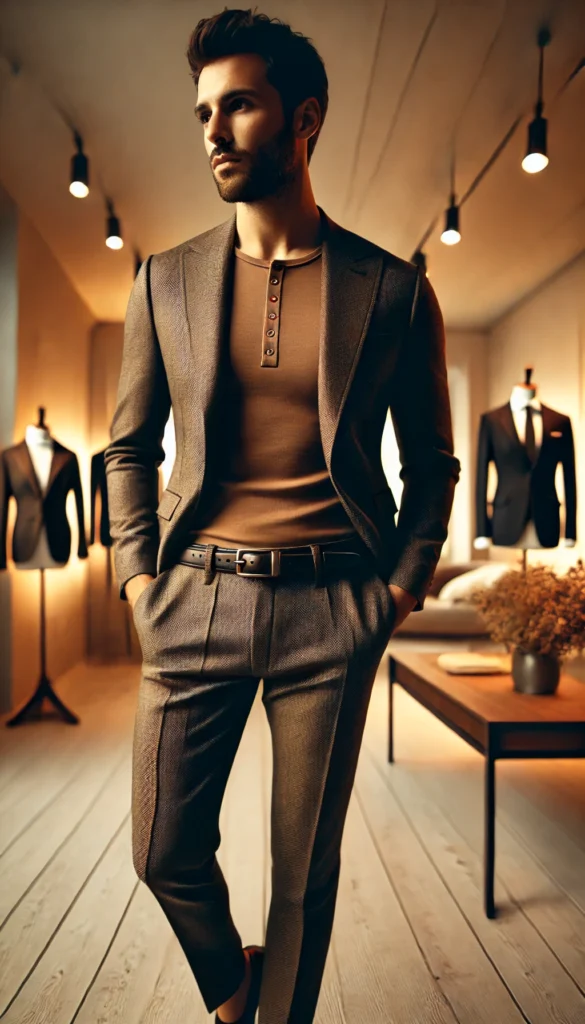
Why Your Clothing Choices Matter (Comfort, Confidence, Expression):
When we talk about what kind of clothes to wear, it’s not just about following trends or dressing up for others it’s about how what you wear affects how you feel, how you function, and how you show up in the world. Here’s why your clothing choices matter more than you might think:
1. Comfort: Your Clothes Should Work with You, Not Against You:
Clothing should never feel like a burden. When you’re uncomfortable tugging at tight sleeves, adjusting waistbands, or overheating in the wrong fabric it’s a constant distraction. Comfortable clothing allows you to move freely, breathe easily, and focus on what really matters in your day.
2. Confidence: What You Wear Shapes How You Feel:
There’s real psychology behind what’s called “unclothed cognition” the idea that clothing can influence your mental state. When you wear something that fits you well and aligns with your sense of style, you naturally feel more confident. You carry yourself differently, speak more assuredly, and are more likely to engage fully in your day.
3. Expression: Your Style Tells a Story Without Words:
Before you even say a word, your outfit communicates something about you. Are you creative, classic, bold, laid-back, adventurous? Clothing is a form of self-expression, and the beauty of it is it can change daily depending on how you feel or what chapter of life you’re in. You don’t have to follow fashion rules or trends to express yourself. Whether it’s a pop of color, a favorite accessory, a vintage jacket, or your go-to pair of jeans your style becomes your personal signature. It’s one of the easiest, most visual ways to show the world who you are and what makes you.
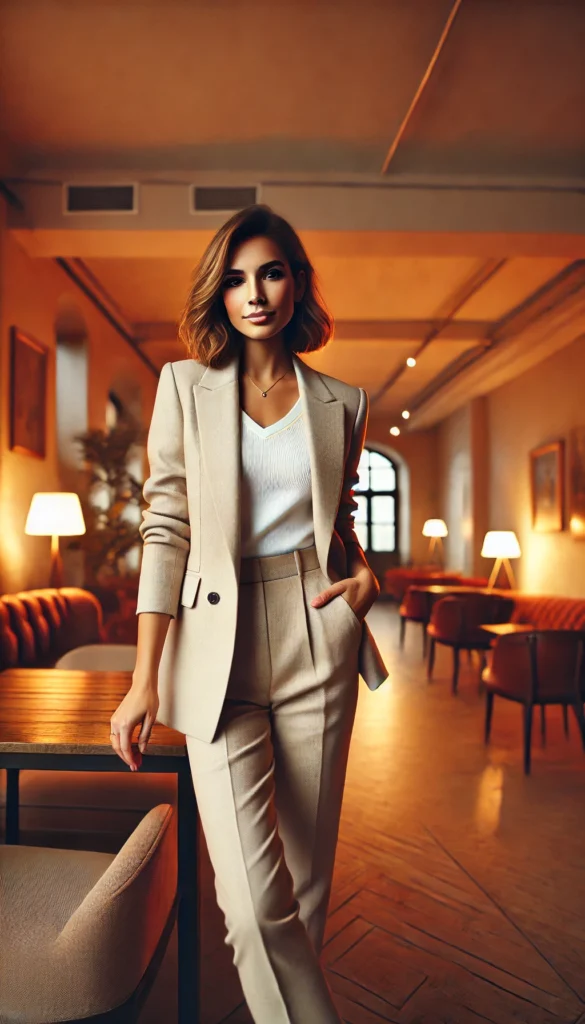
Casual Wear:
When we hear “casual wear,” it might sound like the easiest category but dressing casually doesn’t have to mean sloppy or thoughtless. In fact, casual wear is where comfort meets personal style, and where you have the most freedom to express yourself without the constraints of a dress code.
Whether you’re heading out for coffee with friends, running errands, or just enjoying a relaxed day, casual wear is all about being effortlessly put together while still feeling like yourself.
What Exactly Is Casual Wear?
Casual wear refers to clothing that’s relaxed, informal, and suitable for everyday situations. It’s not meant for boardrooms or black-tie events it’s designed for living in. Think of it as your wardrobe’s most approachable, down-to-earth section.
Some common casual staples include:
Jeans or well-fitted trousers.
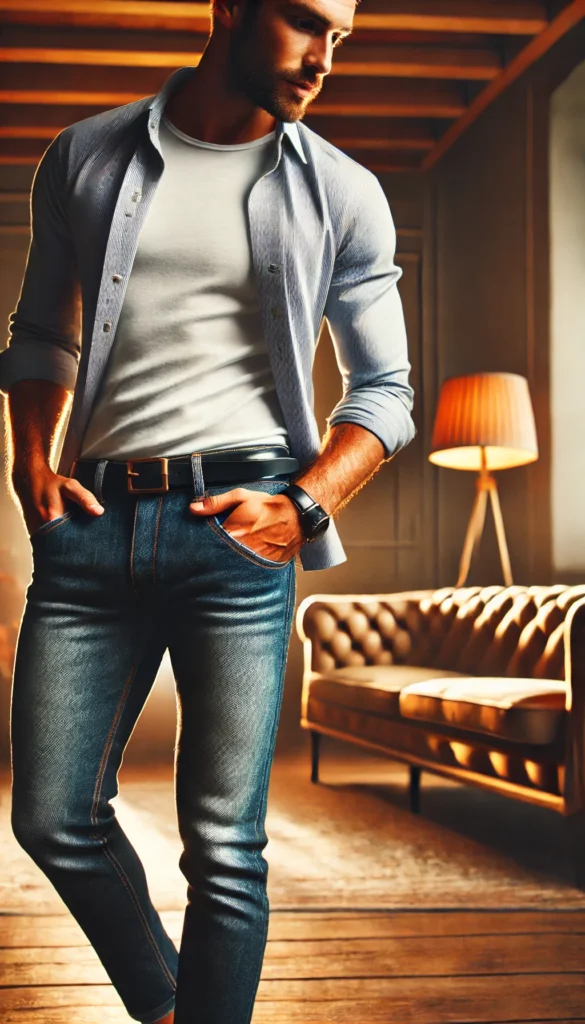
T-shirts, tank tops, or relaxed blouses.
Button-down shirts (untucked or slightly oversized for a relaxed vibe).
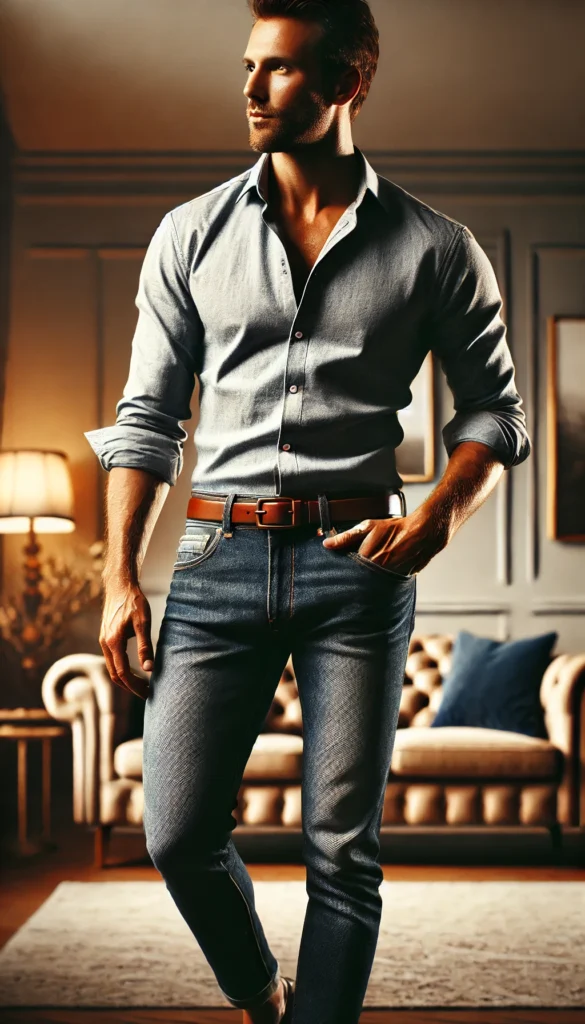
Casual dresses and skirts.
Knit sweaters or cardigans.
Sneakers, flats, sandals, or ankle boots.
Casual doesn’t mean boring these pieces can still be stylish, elevated, and full of personality.
For example:
A basic tee with well-cut jeans and a denim jacket can look effortlessly cool.
Pairing a simple dress with white sneakers and a crossbody bag can turn a laid-back outfit into a chic everyday look.
Athleisure like leggings with a sleek hoodie or a matching set has become a modern casual go-to for many.
If you’re not sure what your casual style is yet, try experimenting with different combinations:
Mix prints with solids.
Try a tucked shirt versus a loose one.
Play with textures like denim, cotton, linen, or knits.
You’ll start to notice what feels the most you.
Casual wear is your everyday companion it’s where style meets ease, and where you get to express your individuality in the most natural way. The key? Choose pieces that feel good on your body, reflect your vibe, and move with your lifestyle.
Work / Professional Attire:
Whether you’re in a corporate office, a creative environment, or working remotely, the way you dress can shape not only how others perceive you, but also how you feel about yourself throughout the day.
Why Professional Attire Matters?
Think of your outfit as your visual handshake. Before you even speak in a meeting or presentation, your clothing has already made an impression. Dressing appropriately for your professional environment shows:
Respect for the role and workplace culture
Readiness and attention to detail
Confidence and self-awareness
But beyond appearances, wearing clothes that feel put-together can also help you feel more focused, motivated, and ready to tackle your day.
Types of Professional Dress Codes:
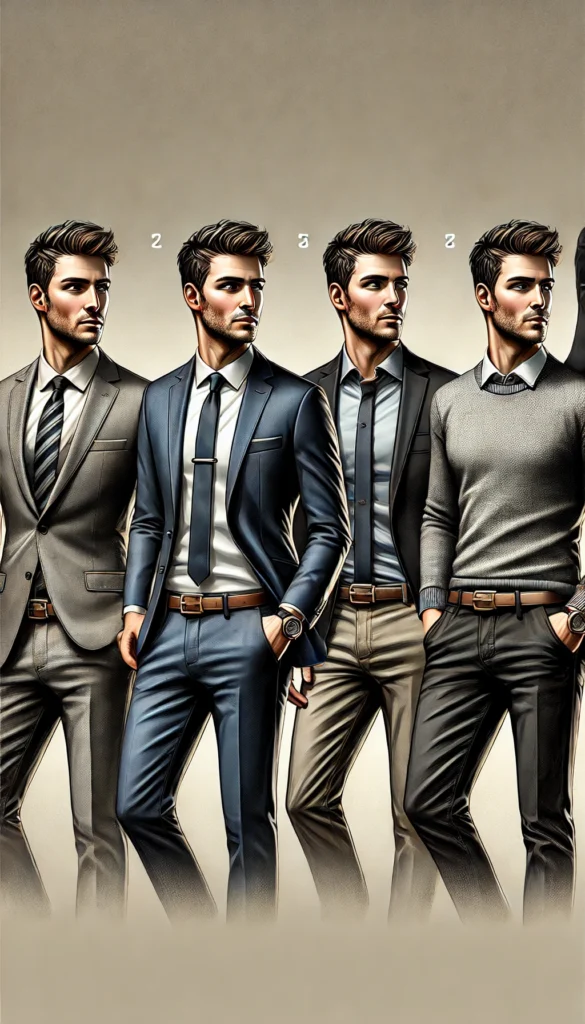
Not all workplaces are created equal and neither are their dress codes. Here’s a quick breakdown of common types of professional attire:
Business Casual:
A more relaxed version of formal wear, common in many modern offices.
Common pieces: dress pants, blouses, midi dresses, smart sweaters, loafers, modest heels.
Tip: You can skip the full suit, but still aim for polished wrinkle-free clothing and clean lines go a long way.
Remote/Work-from-Home Wear:
Comfort is key, but professionalism still matters especially on video calls.
Common pieces: knit tops, button-downs, soft blazers, pull-on trousers or leggings.
Tip: Keep your top half camera-ready, and opt for cozy but presentable bottoms bonus points for looking polished and feeling cozy.
How to Elevate Your Workwear Without Overcomplicating It?
Invest in versatile staples: A few well-fitted blazers, neutral trousers, a sharp pair of shoes, and classic blouses can mix and match effortlessly.
Accessories are your power tool: A sleek watch, statement necklace, or structured handbag can elevate even the simplest outfit.
Maintain your clothes well: Ironed, lint-free, and clean clothing speaks volumes even more than the brand you’re wearing.
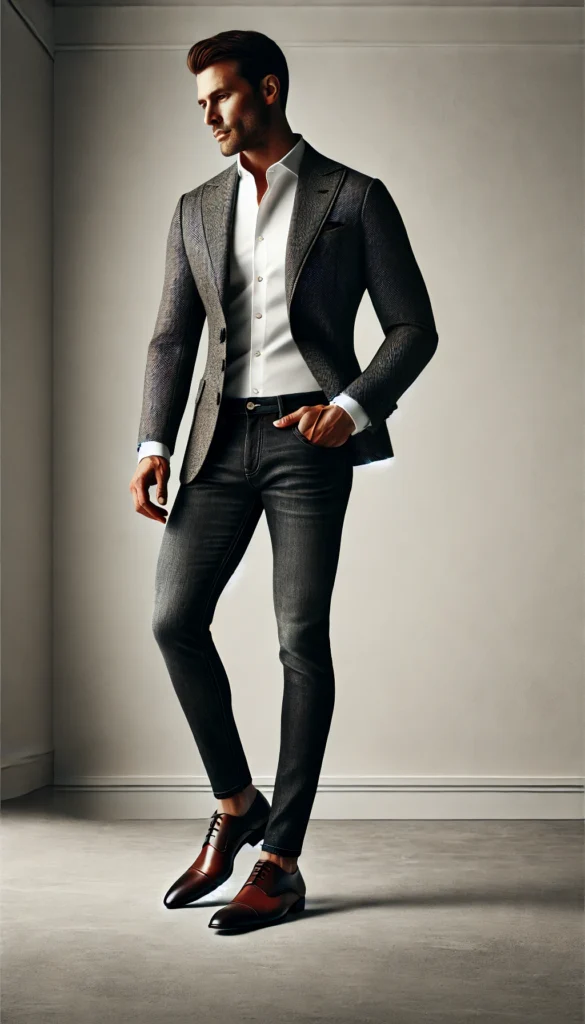
Travel Outfits:
When you’re on the move whether it’s a cross-country road trip, a weekend getaway, or a long-haul flight what you wear can make a huge difference in how comfortable, functional, and confident you feel along the way. Travel outfits are all about striking the perfect balance between comfort, style, and convenience.

The goal? Look presentable while staying cozy and feeling prepared for anything from airport security lines to unexpected weather changes.
Why Travel Outfits Matter:
Traveling often involves a mix of sitting for long periods, moving through different climates, carrying bags, or dealing with delays. Your clothes need to:
Move with you, not restrict you
Help regulate temperature
Be practical for layering and packing
Still make you feel put-together in new surroundings
When you’re dressed well for travel, you feel more in control and ready for the journey whether you’re catching a flight or exploring a new city straight from the train station.
What Makes a Great Travel Outfit?
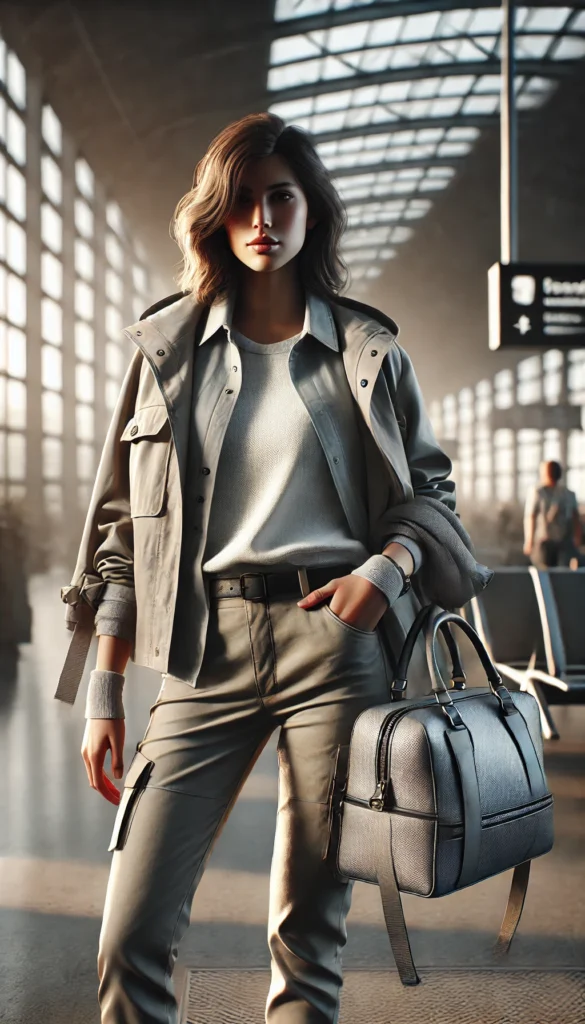
Here are some essential elements that make a travel outfit functional and stylish:
Easy Layers:
Plan for temperature shifts planes and trains can be chilly, but you may warm up while rushing to catch them.
Lightweight sweaters, cardigans, denim jackets, or hoodies are great layering pieces.
A scarf or pashmina can double as a blanket or neck pillow on flights.
Practical Footwear:
Go for supportive, easy-to-slip-on shoes ideal for airport security and all-day wear.
Sneakers, slip-on loafers, or travel sandals work well depending on the destination.
Avoid anything too tight or hard to remove.
Functional Accessories:
Crossbody bags or backpacks keep your essentials secure and accessible.
Sunglasses, travel-friendly jewelry, and a good-quality travel wallet elevate your look without fuss.
Pro Tip: Plan for Versatility:
Try building your travel outfit from items you can reuse or re-style during your trip. For example:
A tunic that doubles as a beach cover-up
A wrap that works as a shawl for dinner
Shoes that pair well with multiple outfits
Travel is easier when your wardrobe is flexible and multifunctional.
Travel Outfit Formula (Simple but Effective)
Comfortable pants or leggings + breathable top + light layer + slip-on shoes + stylish, functional bag
Whether you’re boarding a plane or hopping on a bus, this simple formula keeps you looking effortlessly chic and travel-ready.
Identifying Your Style Archetype:
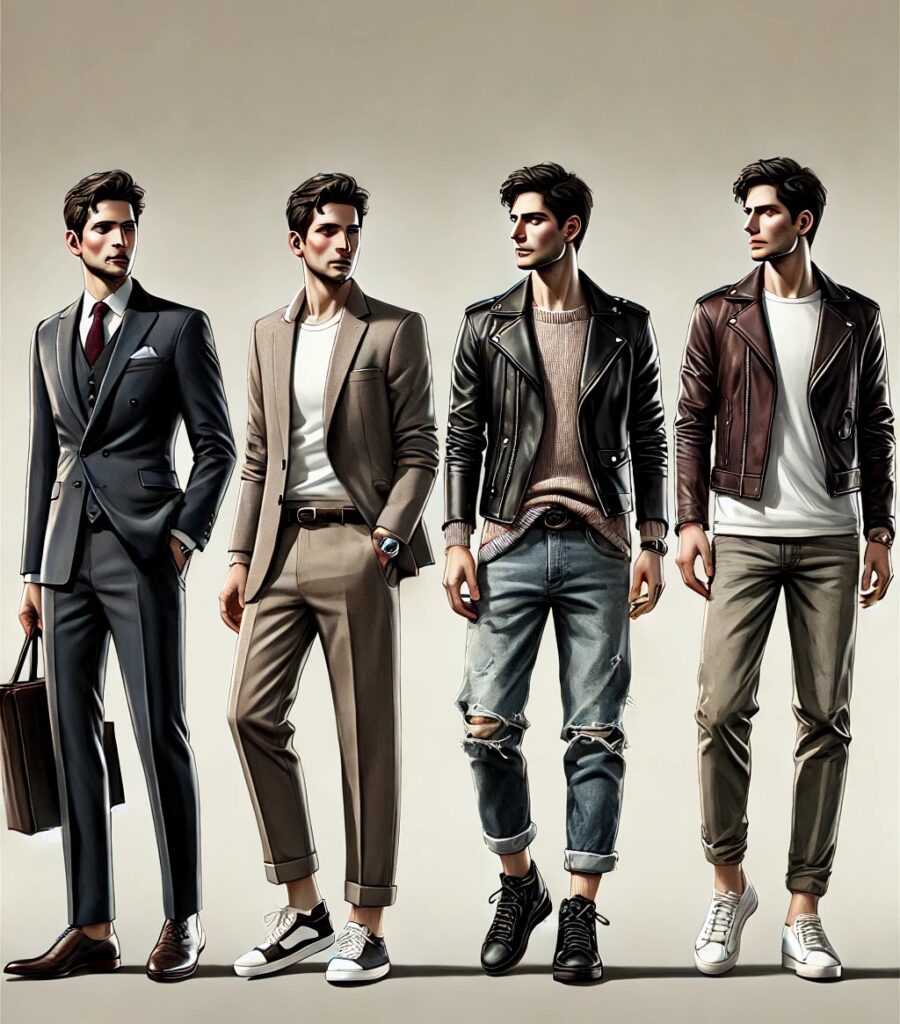
If you’ve ever looked in your closet and thought, “Why doesn’t anything feel like me?” you’re not alone. The key to loving what you wear often lies in discovering and embracing your personal style.
Understanding your style archetype helps you choose clothing that naturally suits your personality, lifestyle, and aesthetic preferences. It makes shopping easier, outfits more cohesive, and dressing up (or down) a lot more fun.
What Is a Style Archetype?
A style archetype is a general category or “style personality” that captures the overall look, mood, and feel of your wardrobe. It’s not about strict rules or limiting labels it’s about recognizing the patterns and preferences that make you feel most you when you get dressed.
Think of it as your wardrobe’s “vibe” and once you find yours, building outfits becomes effortless.
Popular Style Archetypes (And What They Look Like)
Here’s a breakdown of some common style archetypes see which one resonates most with you (or even a combination of a few!):
Classic:
Timeless, polished, elegant.
Think tailored blazers, button-down shirts, trench coats, neutral palettes, pearl earrings.
You prefer structure, clean lines, and pieces that never go out of style.
Bohemian (Boho):
Free-spirited, earthy, relaxed.
Think flowy maxi dresses, fringe details, ethnic prints, wide-brim hats, natural textures like linen or suede.
You love comfort, movement, and a touch of wanderlust in your wardrobe.
Minimalist:
Simple, clean, modern.
Think monochromatic outfits, sharp tailoring, high-quality basics, little-to-no embellishment.
You gravitate toward intentional, well-curated pieces with subtle impact.
Edgy:
Bold, daring, rebellious.
Think leather jackets, ripped denim, dark colors, combat boots, metal accessories.
You love a strong statement and aren’t afraid to stand out or challenge trends.
Romantic:
Feminine, soft, graceful.
Think lace blouses, floral prints, ruffles, pastel colors, delicate accessories.
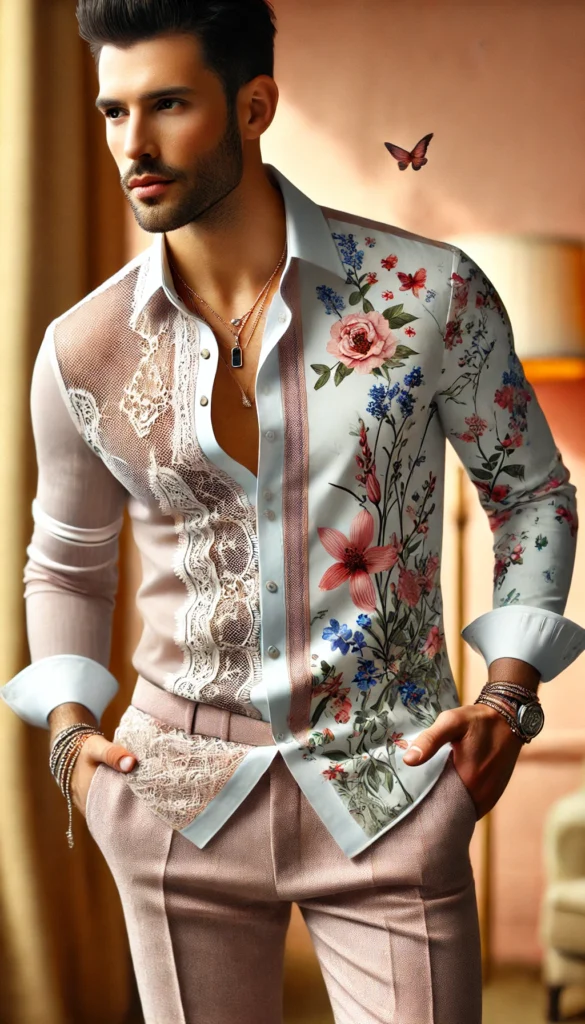
You enjoy softness and detail, and often dress with a vintage or whimsical flair.
Street Style / Urban:
Trendy, expressive, fashion-forward.
Think oversized silhouettes, sneakers, graphic tees, bold colors, mixed textures.
You take cues from current trends and love mixing casual pieces with statement items. How to Identify Your Style Archetype.
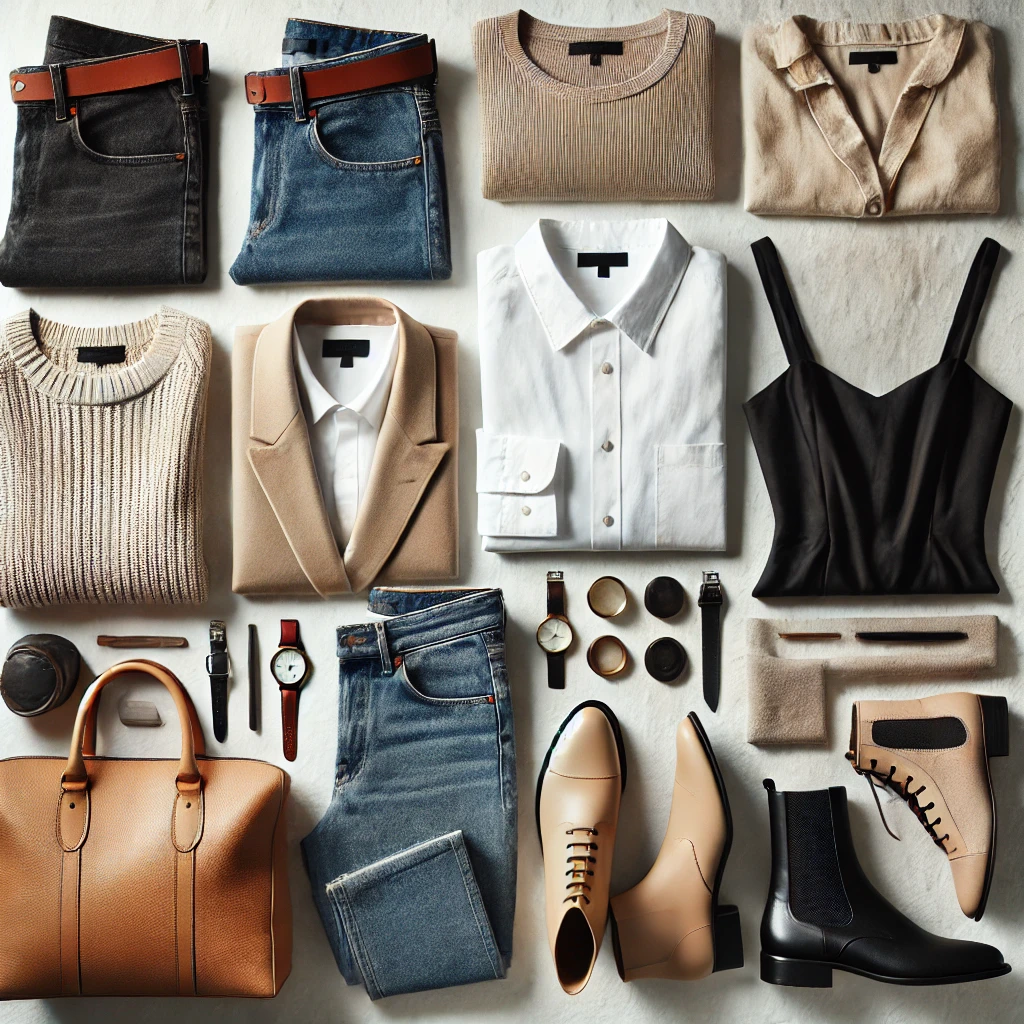
Ask yourself a few questions:
What outfits make me feel most confident and “at home” in my skin?
What do I naturally gravitate toward when shopping?
Which pieces do I wear on repeat without getting tired of them?
What do I save on Pinterest or Instagram for outfit inspiration?
Which celebrity or influencer’s style do I admire most and why?
You might find you lean strongly into one archetype, or you may be a blend like “minimalist-boho” or “classic-edgy.” That’s totally normal your style can be as layered and multifaceted as you are.
Comfort and Functionality Tips:
Here are some essential comfort and functionality tips to help you prioritize both in your wardrobe.
Choose Breathable, Stretch Fabrics:
Why it matters: Breathable fabrics like cotton, linen, wool, or moisture-wicking blends keep you cool and comfortable throughout the day. Stretch fabrics (like spandex, elastane, or jersey) allow for movement, ensuring you’re not restricted by tight clothing.
Comfort Tip: For daily wear, look for items made from these fabrics, especially in warmer climates or when you need to be active. For example, leggings or soft knit dresses are perfect for travel, yoga, or even a casual day out.
Pay Attention to Waistlines and Waistbands:
Why it matters: A waistband that digs into your stomach or a waistline that doesn’t sit comfortably on your body can cause constant discomfort. Whether it’s jeans, skirts, or pants, the right fit around the waist is key to feeling at ease.
Comfort Tip: Look for elastic waistbands, adjustable closures, or pants with a bit of stretch that can accommodate your natural body shape. High-waisted pants can provide more support, while mid-rise or low-rise options can work better depending on your personal preferences.
Functionality Tip: When shopping for work or activewear, check for pieces with hidden, secure pockets or waistbands that can hold your essentials like phone or keys without feeling bulky.
Layering for Versatility and Comfort:
Why it matters: Layering is essential for adjusting to different temperatures and environments. Wearing layers allows you to remove or add clothing throughout the day as needed, keeping you comfortable in fluctuating conditions.
Comfort Tip: Layer breathable fabrics for comfort, such as wearing a cotton T-shirt with a cozy cardigan or a lightweight jacket over a tank top. Choose items with easy-to-remove layers for quick adjustments.
Functionality Tip: Invest in versatile, lightweight outerwear or jackets that can be worn in various seasons. A zip-up hoodie, denim jacket, or lightweight trench coat is practical for layering in any weather and easy to pack for travel.
Footwear That Supports:
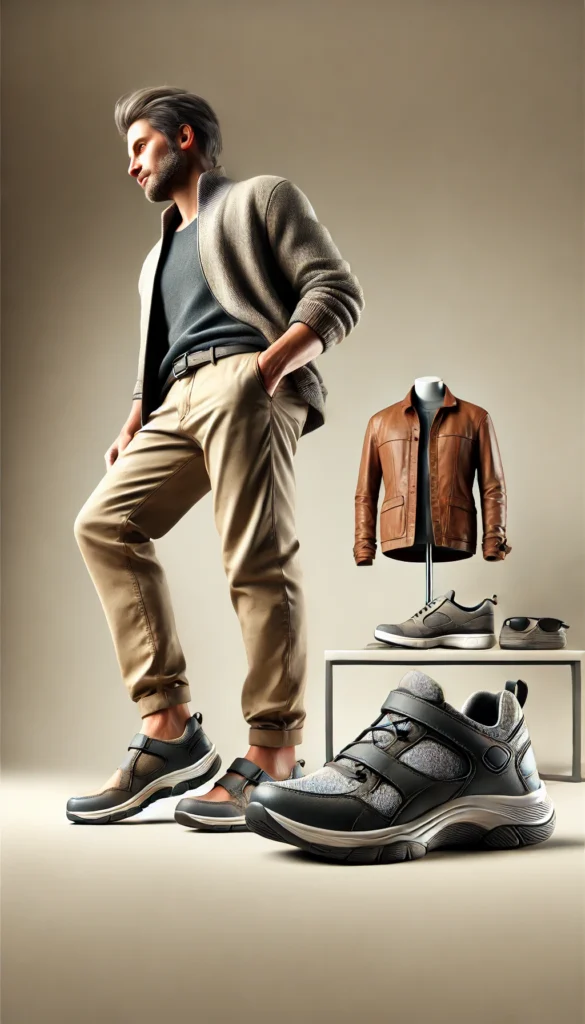
Why it matters: Your feet carry the weight of your body throughout the day, so wearing shoes that are both supportive and comfortable is essential. Whether you’re on your feet all day or walking long distances, the right footwear makes all the difference.
Comfort Tip: opt for shoes that offer cushioning and arch support, like sneakers or slip-on shoes. Shoes with memory foam, padded soles, or ergonomic designs can help reduce strain on your feet.
Functionality Tip: For activewear, look for shoes suited for your specific activity like running shoes for exercise, walking shoes for long hours of standing, or waterproof shoes for wet weather. A good pair of shoes is an investment that will support your feet in the long run.
Keep Fabrics Soft and Non-Irritating:
Why it matters: Rough, scratchy fabrics can quickly lead to irritation, rashes, or simply discomfort. Soft fabrics are gentler on the skin and provide all-day wear ability.
Comfort Tip: Choose fabrics like modal, bamboo, or soft cotton blends, especially for undergarments or clothes worn close to the skin. These fabrics are breathable and gentle, making them perfect for sensitive skin.
Ensure Proper Fit (Not Too Tight or Loose):
Why it matters: Clothes that are too tight may cut into your skin, restricting circulation and causing discomfort, while clothes that are too loose may feel sloppy or unkempt. Properly fitted clothing creates a balance of both comfort and style.
Comfort Tip: Always check how clothes fit across your shoulders, waist, and hips. The fabric should not pinch, roll, or pull in any area. It should allow you to move freely without restriction.
Functionality Tip: For clothes that serve a specific function, such as work or travel, ensure they’re both comfortable and flexible enough to handle different activities. For example, a well-fitted pair of work trousers allows you to sit, stand, and move without discomfort.
Key Staples Everyone Should Own:
Building a versatile wardrobe is all about curating a collection of clothing that is functional, timeless, and adaptable for various occasions. Key staples are the foundation of any great wardrobe these are the essential items that work well across different settings, mix and match easily, and can be dressed up or down. When you have the right staples, you can create endless outfit combinations without feeling overwhelmed by choices.
Let’s break down the key wardrobe staples that everyone should own. These pieces are the backbone of a versatile, functional wardrobe.
1. Classic White Shirt:
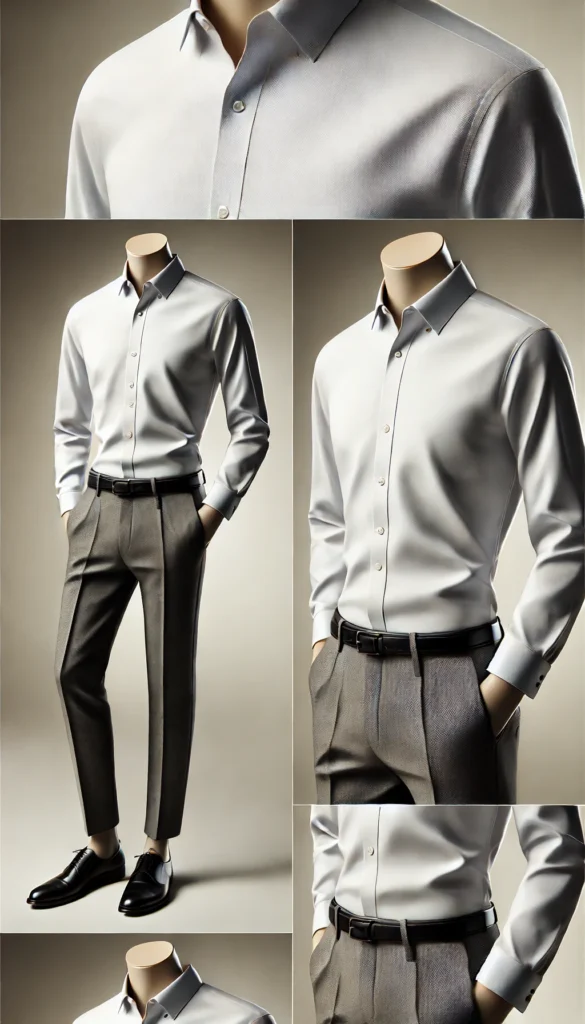
Why it matters: A well-fitted, crisp white shirt is an essential item that can be worn in a variety of ways. It’s timeless, simple, and pairs well with almost anything in your wardrobe. Whether you’re dressing up for a meeting, going for a casual weekend look, or layering it under a sweater, this staple is incredibly versatile.
How to wear it?
Casual: Tuck it into jeans, roll up the sleeves, and add sneakers.
Work: Pair it with tailored trousers or a pencil skirt and a blazer.
Layering: Use it as a base layer under sweaters or jackets for extra warmth.
2.Well-Fitted Jeans:
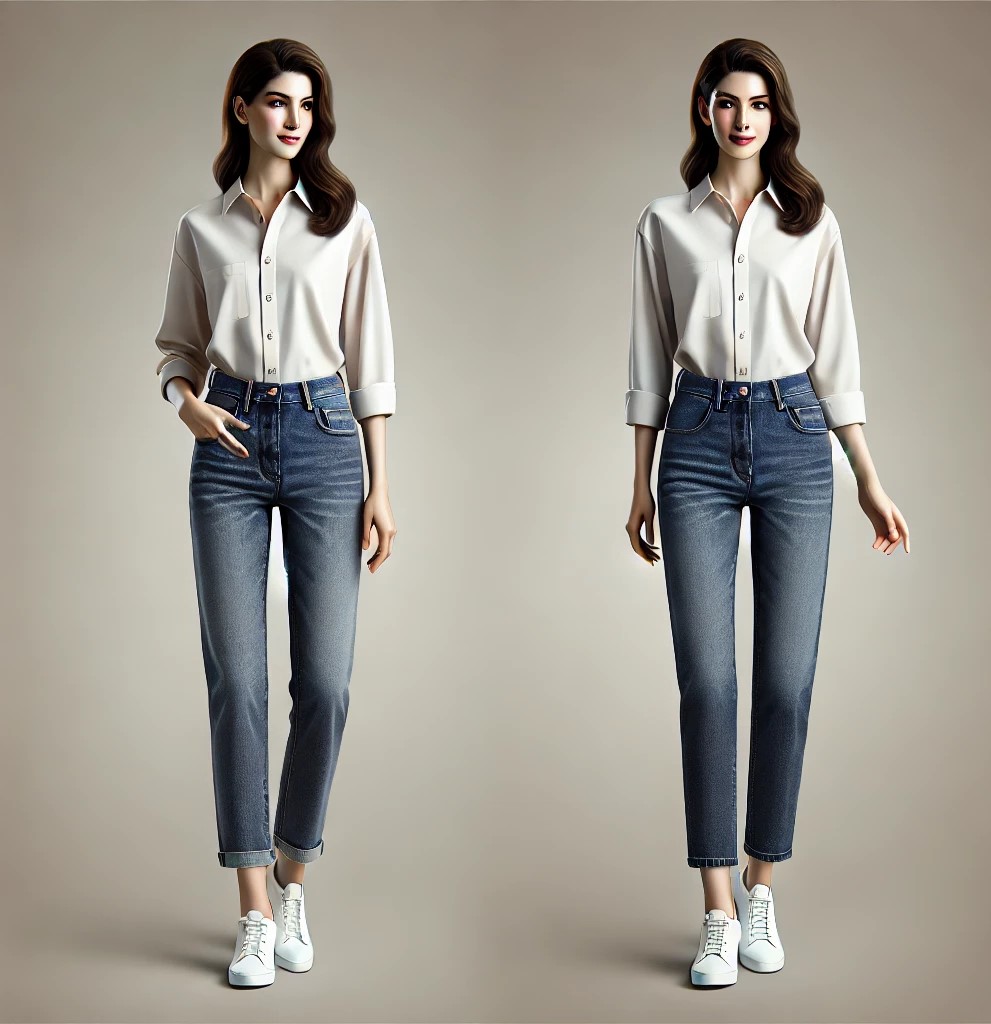
Why it matters: Jeans are arguably the most versatile item you can own. A classic pair of straight-leg, skinny, or bootcut jeans in a neutral wash (dark indigo or black) can be dressed up or down for any occasion. The key is finding a style that fits your body well and makes you feel comfortable.
How to wear it:
Casual: Pair with a simple T-shirt or blouse and sneakers.
Work: Tuck in a blouse or button-down shirt and add a blazer.
Night out: Dress up with heels, a statement blouse, or a sleek leather jacket.
3. Little Black Dress (LBD):
Why it matters: The little black dress (LBD) is a classic staple that works for almost every occasion, from formal events to dinner dates. Its simplicity makes it adaptable, and its elegance is unmatched. Choose a style that flatters your body shape whether it’s a fit-and-flare, sheath, or A-line silhouette.
How to wear it:
Casual: Pair with flats and a denim jacket.
Work/Events: Add a tailored blazer and classic pumps.
Evening: Dress it up with bold jewelry, a clutch, and heels.
4. Blazer:
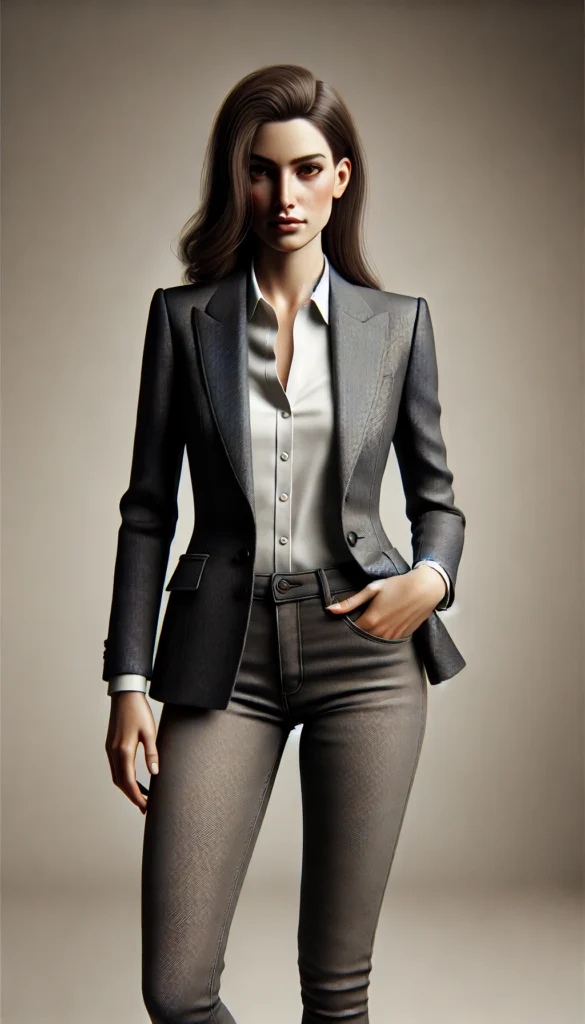
Why it matters: A well-tailored blazer is an essential piece that adds structure and polish to any outfit. A neutral-colored blazer (black, navy, or gray) can instantly make even casual outfits appear more sophisticated. It’s perfect for business settings but can also work for smart-casual and evening looks.
How to wear it:
Work: Pair with trousers, skirts, or dresses for a professional look.
Casual: Throw it over a T-shirt or blouse with jeans or leggings.
Evening: Layer over a dress to add polish for a night out.
5. Versatile Outerwear:
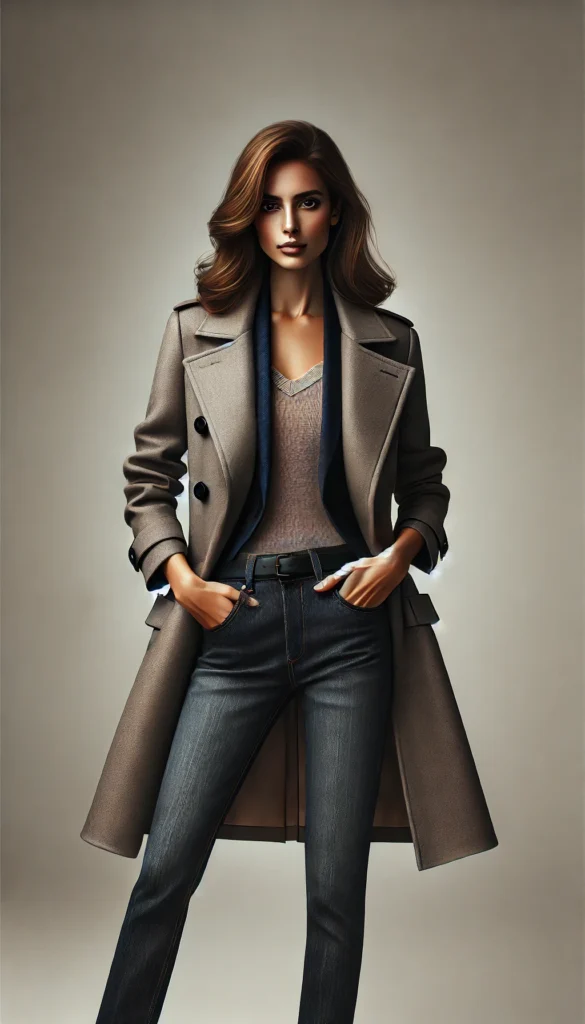
Why it matters: A well-fitted coat or jacket is essential for layering and keeping warm. A trench coat or tailored jacket works year-round and is ideal for transitioning between seasons. Choose one in a neutral shade like camel, black, or navy for maximum versatility.
How to wear it:
Casual: Throw it over a sweater and jeans.
Work: Pair with tailored trousers and a blouse for a sleek, professional look.
Evening: Layer over a dress for extra warmth and sophistication.
6. White Sneakers:
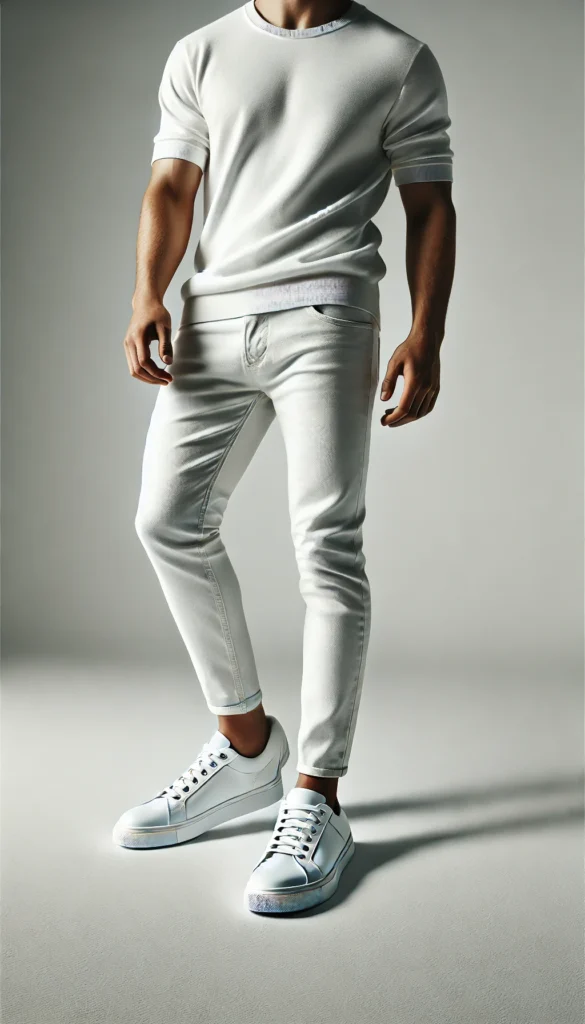
Why it matters: A clean pair of white sneakers is a versatile, go-to footwear choice that can work with a wide range of outfits. They’re not only comfortable but also give off a relaxed, laid-back vibe while maintaining a stylish edge.
How to wear it:
Casual: Pair with jeans, leggings, or a casual dress.
Work-casual: Wear with tailored trousers and a blouse for a smart-casual look.
Travel: Ideal for comfort and ease when you’re on the go.
Body Types:
1. Pear Shape (Triangle):
A pear-shaped body is characterized by wider hips and thighs, with a smaller waist and shoulders. Individuals with this body shape typically have a narrower upper body and a fuller lower body.
Key Features of Pear Shape:
Narrow shoulders
Defined waist
Wider hips and thighs
Often a smaller bust
Clothing Tips for Pear Shape:
Emphasize your upper body: Draw attention to your shoulders and upper torso with tops that have details like ruffles, patterns, or statement collars. This can help balance out the proportions of the hips.
A-line skirts or dresses: These shapes flare out from the waist, flattering the hips and thighs without adding extra volume.
Dark-colored bottoms: opt for darker colors or more structured fabrics for pants, skirts, and jeans to streamline the lower half of your body.
Avoid overly clingy fabrics: On the lower half, avoid clothing that clings too tightly to the thighs or hips, as it can accentuate the areas you may want to minimize.
2. Apple Shape (Round):
An apple-shaped body typically features a wider midsection, with narrower hips and legs. The weight tends to accumulate around the abdomen, making the waistline less defined.
Key Features of Apple Shape:
Fuller, rounder midsection.
Smaller hips and thighs.
Narrower legs.
Often larger bust.
Clothing Tips for Apple Shape:
Define your waist: Use belts or dresses with a slightly higher waistline to create the illusion of a more defined waist. This helps avoid the “boxy” look and adds shape.
V-necklines: Tops with V-necks create a slimming effect and draw attention upward toward the face and shoulders.
Empire waist dresses: These dresses have a raised waistline just under the bust, which creates a more defined waist and lets the fabric flow down over the midsection.
Straight or bootcut pants: These styles balance out the proportions of the body without clinging to the midsection.
Avoid overly tight clothing: Clothes that are too tight around the stomach area can draw unwanted attention to the midsection. opt for looser, more structured pieces that skim over the body.
3. Hourglass Shape:
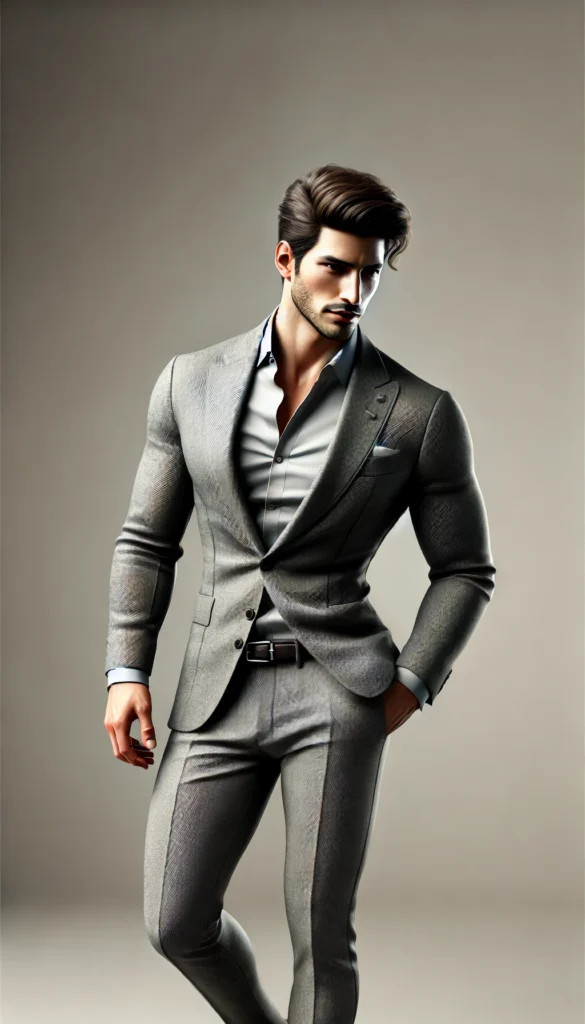
The hourglass shape is often considered the most balanced body type. It is defined by a well-proportioned bust and hips with a defined waist that creates the iconic “curvy” silhouette.
Key Features of Hourglass Shape:
Proportional bust and hips
Defined waist
Curvy figure
Clothing Tips for Hourglass Shape:
Embrace fitted clothing: Hourglass figures are often best showcased by clothing that fits snugly around the waist, such as tailored tops, dresses, and jackets.
Belted styles: Belts or waistbands that cinch the waist are perfect for accentuating curves.
Structured, form-fitting pieces: Pencil skirts, tailored trousers, and dresses that emphasize the waist work well for this shape.
Avoid overly loose clothing: Clothing that is too baggy can hide your natural curves and make you appear shapeless. Instead, opt for styles that follow the lines of your body.
Necklines and details: V-necks, scoop necks, and sweetheart necklines work well, as they highlight the bust without overwhelming the proportions
4. Rectangle Shape (Athletic):
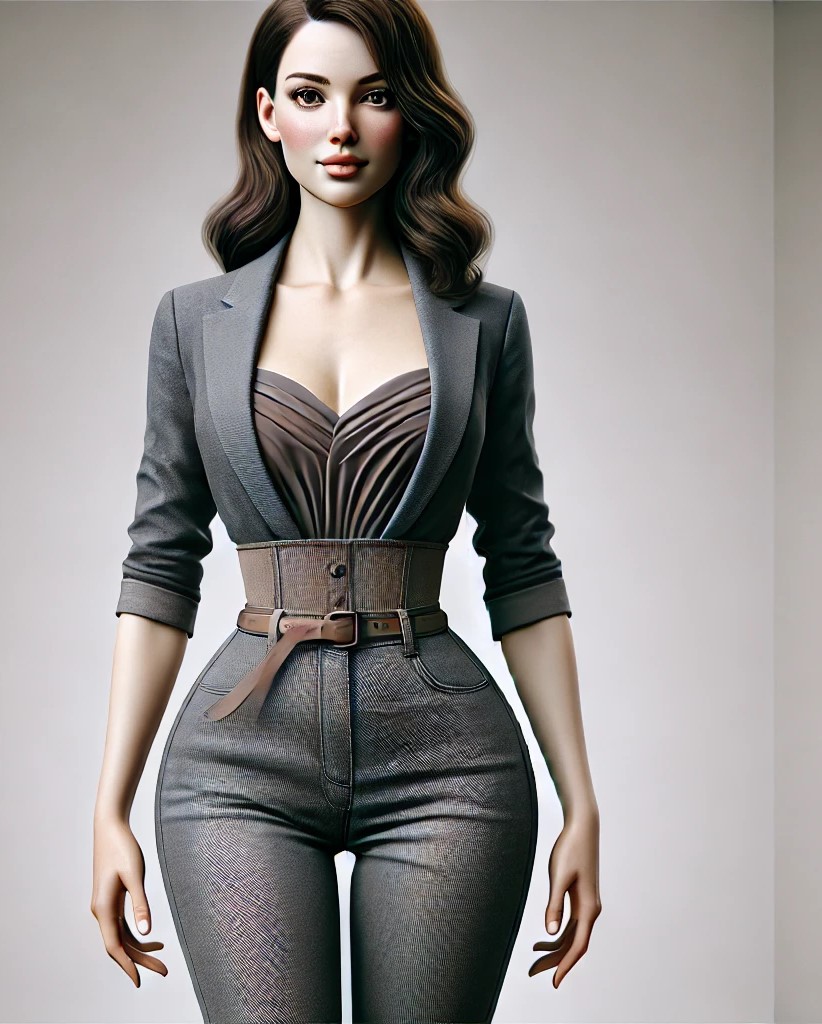
The rectangle body shape, often referred to as an athletic body, is characterized by balanced proportions, with shoulders, waist, and hips all about the same width. There is less definition around the waist, creating a straighter silhouette.
Key Features of Rectangle Shape:
Shoulders, waist, and hips are about the same width
Less definition at the waist
Often lean and straight
Clothing Tips for Rectangle Shape:
Create curves: To create the illusion of curves, focus on adding volume to your hips and bust. Peplum tops, skirts with pleats, and dresses with gathered fabric around the waist can help create curves.
Define the waist: A well-defined waist can make a big difference for the rectangle body type. Try wearing belts, fitted jackets, or dresses that cinch at the waist to add shape.
Layering and texture: Layered looks or textured fabrics (like ruffles or pleats) can add dimension and make the figure appear more curvy.
A-line skirts and dresses: These can add balance to your shape, giving the illusion of more defined hips and waist.
Avoid boxy styles: Very boxy or shapeless clothing can emphasize the straightness of your silhouette. Instead, look for tailored or structured pieces that add shape to the body.
5. Inverted Triangle Shape:
The inverted triangle body shape is defined by broad shoulders and a larger bust, with a narrower waist and hips. People with this body shape often have a more athletic or broad-shouldered appearance.
Key Features of Inverted Triangle Shape:
Broad or wide shoulders.
Larger bust.
Narrow waist and hips.
Clothing Tips for Inverted Triangle Shape:
Balance your shoulders: To soften the appearance of broad shoulders, look for tops with narrower shoulder lines, or add volume to the hips with flared skirts or wide-leg pants.
V-necklines: A V-neck or scoop neck creates a slimming effect, drawing attention away from the shoulders and elongating the neck.
Wide-leg pants or skirts: These helps create a more balanced look by adding volume to the lower body.
A-line dresses or skirts: These styles help create the illusion of a more defined waist and add fullness to the hips.
Avoid shoulder pads or bulky tops: These can exaggerate broad shoulders. Instead, opt for tops that fit well and have simple, streamlined cuts.
Finding Your Undertones:
When it comes to choosing colors that flatter your skin and enhance your overall appearance, understanding your undertones is crucial. Undertones are the subtle hues that lie beneath the surface of your skin, and they influence how different colors appear when you wear them. Unlike skin tone, which refers to the surface color of your skin (e.g., fair, medium, dark), undertones are the colors that give your skin its depth and warmth. Knowing your undertone helps you pick clothing, accessories, and even makeup that complement your natural coloring.
Let’s dive into the different undertone categories, how to identify yours, and which colors suit each type best.
1. Cool Undertones:
Cool undertones typically have a pink, red, or blue base. People with cool undertones tend to have skin that may appear to have a rosy or bluish tint, and their veins often look blue when viewed through the skin. Individuals with cool undertones generally burn more easily in the sun and have a fair to medium skin tone, although they can also appear in darker complexions.
How to Identify Cool Undertones:
Your skin may have a rosy or blueish hue.
Your veins appear more blue than green.
Silver jewelry tends to look better on you than gold.
You tend to burn quickly or turn pinkish in the sun.
Flattering Colors for Cool Undertones:
Jewel tones: Rich colors like emerald green, sapphire blue, royal purple, and amethyst are excellent choices for people with cool undertones.
Cool shades of blue: Think navy, cobalt, and icy blue, which complement the cool undertones.
Pink, lavender, and plum: Soft and vibrant shades of pink, lavender, and plum work beautifully with cool undertones.
True red: Red shades with a blue base (like cherry red) look great on people with cool undertones.
Icy tones: Colors like icy lavender, frosty pink, and silver are stunning on those with cool undertones.
2. Warm Undertones:
Warm undertones are characterized by yellow, peach, or golden hues beneath the skin. People with warm undertones often have skin that appears to have a golden or yellowish tint. Their veins tend to look greenish when viewed through the skin, and they usually tan easily in the sun. Warm undertones are common in individuals with darker skin tones, but they can also appear in fair to medium complexions.
How to Identify Warm Undertones:
Your skin may have a golden, yellow, or peach tint.
Your veins appear more green than blue.
Gold jewelry tends to look better on you than silver.
You tend to tan easily in the sun and may rarely burn.
Flattering Colors for Warm Undertones:
Earthy tones: Warm shades like terracotta, olive green, mustard yellow, and brown work well for people with warm undertones.
Warm reds and oranges: Colors like coral, brick red, and pumpkin orange complement warm undertones beautifully.
Yellow and gold: Golden yellow and rich mustard are ideal for enhancing the warm glow of the skin.
Warm greens: Shades like forest green, moss, and olive green flatter warm undertones.
Peach and warm pinks: Soft peach, salmon, and warm rose tones are excellent choices for those with warm undertones.
3. Neutral Undertones:
Neutral undertones are a balance between both warm and cool undertones. People with neutral undertones often have skin that doesn’t lean strongly towards either pink or yellow, and their veins may appear to be a mixture of both blue and green. Individuals with neutral undertones can usually wear a wide range of colors, making it easier for them to pull off both cool and warm tones.
How to Identify Neutral Undertones:
Your skin appears neither too pink nor too yellow and has a more neutral, balanced tone.
Your veins may appear to be both blue and green.
Both silver and gold jewelry look equally flattering on you.
You have more flexibility with colors and tend to look great in a wide range of hues.
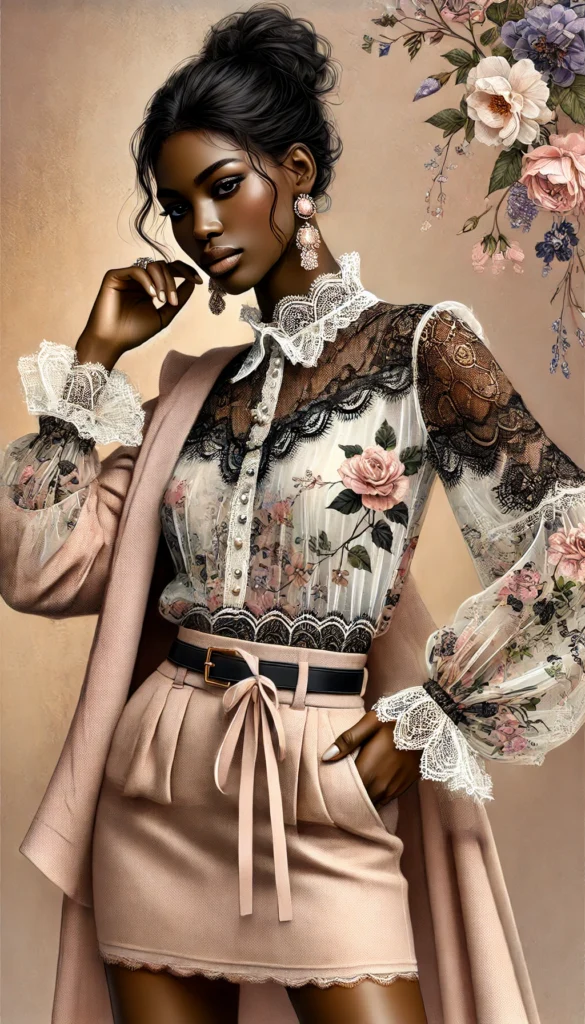
Flattering Colors for Neutral Undertones:
Soft shades of both warm and cool tones: People with neutral undertones can wear a wide variety of colors, from cool blues to warm greens, and everything in between.
True colors: Colors that are neither too warm nor too cool, such as pure red, turquoise, and jade green, tend to look great on neutral undertones.
Muted or soft shades: Soft peach, blush pink, soft lavender, and dusty rose are great for adding a natural glow without overwhelming the complexion.
Gray and cool beige: Neutral undertones can wear gray and shades of beige without the colors clashing with their skin.
How to Find Your Undertone?
Finding your undertone is not always as simple as it sounds, but there are several methods you can use to determine it. Here are some popular ways to identify your undertone:
1. The Vein Test:
Look at the veins on the underside of your wrist.
If your veins appear blue or purple, you likely have cool undertones.
If your veins appear green, you likely have warm undertones.
If your veins look like a mix of both blue and green, you may have neutral undertones.
2. The Jewelry Test:
Hold both silver and gold jewelry up to your skin.
If silver jewelry looks better on you, you likely have cool undertones.
If gold jewelry looks better on you, you likely have warm undertones.
If both silver and gold jewelry suit you equally well, you likely have neutral undertones.
3. The White Paper Test:
Hold a piece of white paper up to your face in natural light.
If your skin appears more rosy or pink against the white paper, you likely have cool undertones.
If your skin appears more yellow or golden against the white paper, you likely have warm undertones.
If there’s no obvious color shift and your skin appears neutral, you likely have neutral undertones.
4. The Sun Reaction Test:
Think about how your skin reacts to the sun.
If you burn easily and don’t tan much, you likely have cool undertones.
If you can easily and rarely burn, you likely have warm undertones.
If you burn and then tan, you may have neutral undertones.
Why Finding Your Undertone Matters?
Knowing your undertone is essential because it helps you:
Choose the right colors for your wardrobe, making you look more vibrant and well-coordinated.
Pick makeup shades that enhance your natural beauty, including foundation, blush, lipstick, and eyeshadow.
Feel confident by wearing colors that complement your skin and highlight your best features.
How to Choose Colors that Suit Your Skin Tone:
Choosing colors that flatter your skin tone can have a significant impact on how you look and feel in your clothes. When the right colors are worn, they can enhance your complexion, brighten your face, and even make you look more awake and vibrant. Conversely, wearing the wrong colors may make you look tired, washed out, or unbalanced.
To help you select colors that suit your skin tone, it’s important to first understand the concept of skin tones and undertones, as they play a critical role in determining what colors work best for you. Your skin tone refers to the surface color of your skin (fair, medium, olive, dark, etc.), while your undertones refer to the subtle hues beneath the surface, which can be cool, warm, or neutral.
Here’s a guide to understanding how to choose the best colors for your skin tone and undertones.
1. Understanding Your Skin Tone:
Your skin tone can be classified into different categories, which help you identify the most flattering shades for your clothing. It’s crucial to know whether your skin tone is light, medium, olive, or dark, as this can influence the colors that complement your complexion.
Fair Skin Tone:
People with fair skin usually have pale or light skin that can be prone to burning in the sun. They often have either cool or neutral undertones.
Flattering colors for fair skin include soft pastels, light blues, soft pinks, lavender, and cool shades of green. These colors contrast gently with the light skin, creating a fresh and balanced appearance.
Avoid: Overly bold, neon, or dark colors, which can make the skin appear washed out or too harsh.
Medium Skin Tone:
Medium skin tones are typically tan or olive-colored, with a more even or warm complexion. People with medium skin can have both warm and neutral undertones.
Flattering colors for medium skin include jewel tones such as emerald green, ruby red, sapphire blue, and deep purples. These colors bring out the richness of medium skin without overwhelming it.
Avoid: Pale or pastel colors, as they may not provide enough contrast against medium skin and can make the complexion appear dull.
Olive Skin Tone:
Olive skin has a yellowish or greenish undertone. It can range from light to deep, with varying amounts of warmth.
Flattering colors for olive skin include earthy tones like terracotta, warm greens, mustard, and rich browns. These shades help highlight the warmth and depth of the skin tone.
Avoid: Cool, icy colors like pastel blues or cool purples, as they may clash with the yellowish undertones of olive skin.
Dark Skin Tone:
Dark skin tones range from deep brown to rich, ebony shades. People with dark skin often have warm undertones, though they can also have neutral undertones.
Flattering colors for dark skin include bright, bold shades like vibrant yellows, royal blue, deep reds, and rich purples. These colors complement the depth of the skin and provide beautiful contrast.
Tips for Choosing Colors Based on Skin Tone and Undertone:
Once you know whether you have a cool, warm, or neutral undertone, here are some tips to help you choose colors that will suit your skin tone:
Consider Seasonal Color Palettes:
Some people identify with the seasonal color system, which assigns colors based on the four seasons. For example:
Winter (cool undertones): You’ll look great in cool-toned colors like black, white, navy, and jewel tones.
Summer (cool undertones): Pastels and soft hues like lavender, rose pink, and soft blues work well.
Autumn (warm undertones): Earthy tones such as rust, mustard, and olive green enhance the warmth in your skin.
Spring (warm undertones): Light, warm colors like coral, peach, and aqua are perfect for spring.
Match Colors to Your Face:
When choosing colors for clothing, remember that colors near your face (like tops, scarves, and accessories) have the greatest impact on how your skin tone and complexion appear. Focus on finding the right colors for your upper body and accessories, as they are closest to your face and will help you look your best.
Play with Contrast:
If you want to make a bold fashion statement, consider contrasting colors. For example:
Cool undertones may contrast well with deep jewel tones like emerald and sapphire.
Warm undertones can create stunning contrasts with bold reds, yellows, and oranges.
Neutral undertones have the freedom to experiment with both contrast and harmony, making them versatile in color choices.
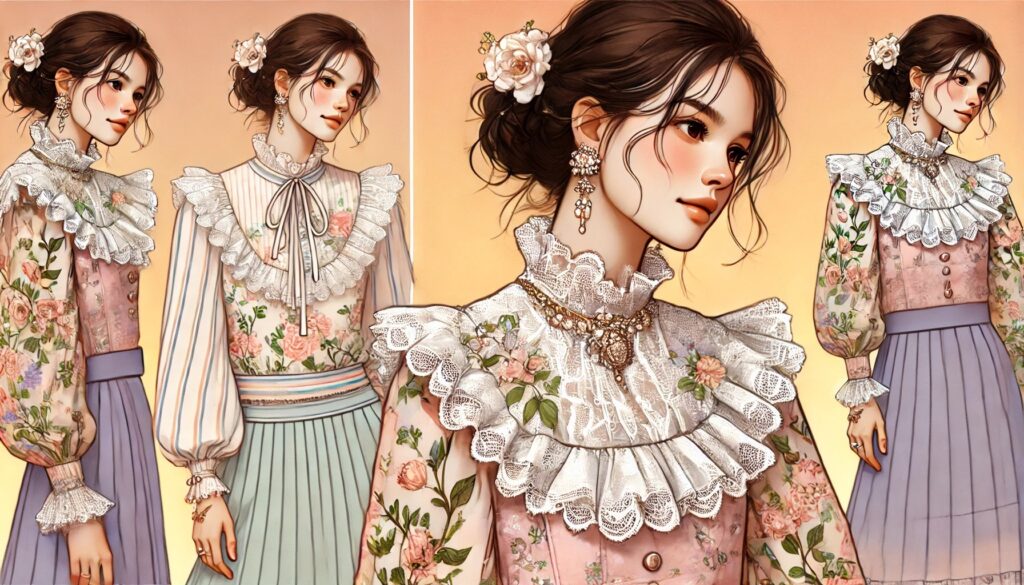
Personality-Based Fashion:
Fashion is more than just about following trends or fitting into certain societal expectations; it’s a reflection of who you are as a person. Personality-based fashion allows you to express your individuality through your clothing choices, ensuring that your style not only suits your body but also aligns with your personal traits, lifestyle, and emotional expression. This approach to fashion can help you develop a signature style a unique wardrobe that feels authentically “you.”
Here’s how personality-based fashion can influence your style, and how to embrace it in a way that makes you feel empowered and confident.
1. The Role of Personality in Fashion Choices
Your personality plays a significant role in determining the types of clothes you feel most comfortable and confident in. Fashion is an extension of your identity, and it should complement who you are on the inside. By considering your traits, preferences, and lifestyle, you can curate a wardrobe that feels true to you.
Traits and Fashion Expression:
Introverts may gravitate toward more muted, minimalist clothing—comfortable and understated pieces that don’t draw too much attention. Soft colors, simple cuts, and cozy fabrics may feel more in line with their more reserved nature.
Extroverts may prefer bold, statement-making outfits that attract attention. Bright colors, patterns, and eye-catching accessories can be a great fit for individuals who thrive in social situations and enjoy being the center of attention.
Creative individuals might lean toward eclectic, unconventional, or artistic clothing. This could include combining different textures, styles, or cultural influences that express their originality.
Pragmatic individuals may favor functional, no-nonsense clothing. Think durable fabrics, classic cuts, and versatile pieces that can easily transition from work to weekend activities.
2. Building a Wardrobe Around Your Personality
To develop a wardrobe that complements your personality, start by considering the following:
Know Your Lifestyle:
Your lifestyle has a big impact on your personal style. Whether you’re a busy professional, a student, a creative, or someone who enjoys outdoor activities, your clothes should reflect both your personality and the activities you participate in daily.
For busy professionals: You might favor classic, polished clothing like tailored suits, button-up shirts, and blouses that convey confidence and competence. The materials and cuts you choose should match your busy day-to-day routines—think wrinkle-resistant fabrics and versatile pieces.
For creatives or artists: Your wardrobe might include more artistic or bohemian elements—looser, layered clothing, vibrant prints, and unique accessories that reflect your free-spirited, imaginative nature. For athletes or outdoor lovers: Comfortable, activewear-inspired clothing or practical, utilitarian items such as cargo pants, sneakers, and durable jackets could speak to your love for movement and adventure.
3. Incorporating Personal Preferences:
most at ease. Do you enjoy wearing bold colors, or do you feel more comfortable in neutral tones? Do you prefer structure, or are you drawn to flowy and relaxed silhouettes? Let these preferences guide your wardrobe choices.
Comfort and practicality: If you prioritize comfort, fabrics like cotton, knit, and soft wool might be your go-to materials. You may gravitate toward loose-fitting clothes, cozy sweaters, and shoes you can walk in all day.
Bold and confident:
If you’re the type of person who loves to stand out, you might enjoy experimenting with vibrant colors, sharp silhouettes, or attention-grabbing accessories like statement jewelry, hats, or handbags.
Expressing Emotions Through Fashion:
Fashion can also reflect your moods and emotions. Think about how your clothing can communicate how you’re feeling on any given day, whether that’s excitement, confidence, relaxation, or even introspection.
On days when you want to feel empowered and confident, you might opt for structured outfits, bold prints, or colors like red, black, and gold that convey strength and authority.
On more calm or reflective days, you may choose softer fabrics and colors, such as pastel tones or neutrals, that promote a sense of peace and serenity.
For playful or creative days, you might choose quirky patterns, bright colors, and fun accessories that reflect your lightheartedness.
Identifying Your Style Archetype:
you can think of certain style archetypes that align with your traits and preferences. Understanding these archetypes can help you discover how to express yourself more authentically through fashion.
Some common style archetypes include:
Classic:
Personality: Traditional, elegant, refined.
Style Elements: Neutral colors, tailored cuts, timeless pieces like trench coats, blazers, and simple dresses.
Example: Audrey Hepburn’s chic, polished look.
Why it works: If you prefer timeless elegance and simplicity, this style is for you. Classic wardrobes focus on investment pieces that never go out of style.
Boho:
Personality: Free-spirited, artistic, laid-back.
Style Elements: Flowing fabrics, ethnic prints, fringe, earthy tones, vintage-inspired pieces.
Example: Sienna Miller’s carefree bohemian look.
Why it works: If you’re drawn to a relaxed, natural vibe, boho style celebrates individuality and eclectic fashion, often inspired by travel and creativity.
Minimalist:
Personality: Practical, straightforward, organized.
Style Elements: Simple, clean lines, neutral colors, versatile pieces, and quality fabrics.
Example: The pared-back looks of Meghan Markle or Victoria Beckham.
Why it works: Minimalism embraces less-is-more philosophy, focusing on a streamlined, efficient wardrobe that’s easy to mix and match.
Edgy/Street Style:
Personality: Bold, rebellious, confident.
Style Elements: Leather jackets, graphic tees, combat boots, distressed denim, bold accessories.
Example: Rihanna’s street style with its daring and unconventional flair.
Why it works: If you embrace individuality and aren’t afraid to take risks, edgy or street style can reflect your fearless personality through clothing choices.
Romantic: Personality: Feminine, soft, dreamy.
Style Elements: Soft fabrics like lace, ruffles, floral patterns, pastel colors.
Example: The delicate, romantic looks of Emma Watson or Keira Knightley.
Why it works: Romantic style embraces softness and elegance, often evoking a sense of nostalgia and grace.
Experimenting with Fashion:
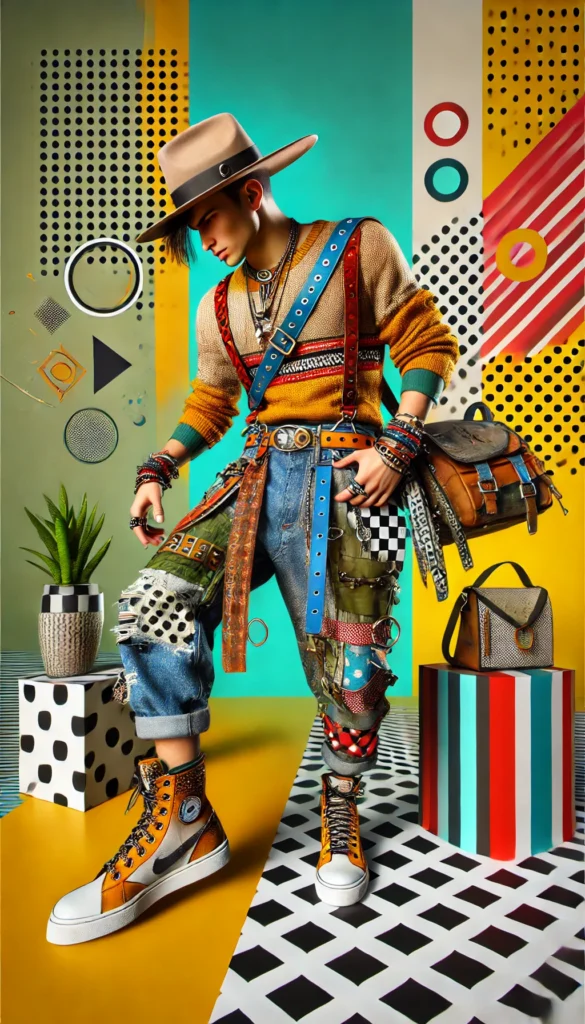
As you develop your signature style, it’s important to experiment with different looks and textures to find what works best for you. Don’t be afraid to mix and match different elements—combine classic pieces with edgier accents or play with boho and minimalist combinations.
Try new things: If you’re drawn to one style archetype but curious about another, try adding small elements of that style to your wardrobe. For instance, if you’re primarily minimalist but love the laid-back vibes of boho, you could incorporate a fringed bag or a flowing kimono into your usual look.
Play with colors and textures: Experiment with what feels right for your mood or season. For instance, if you’re feeling adventurous, add bold colors or unique fabrics, but on days when you’re feeling more reserved, choose neutral tones or soft textures.
The goal is to personalize your wardrobe by blending different influences that reflect your personality while making you feel confident and comfortable.
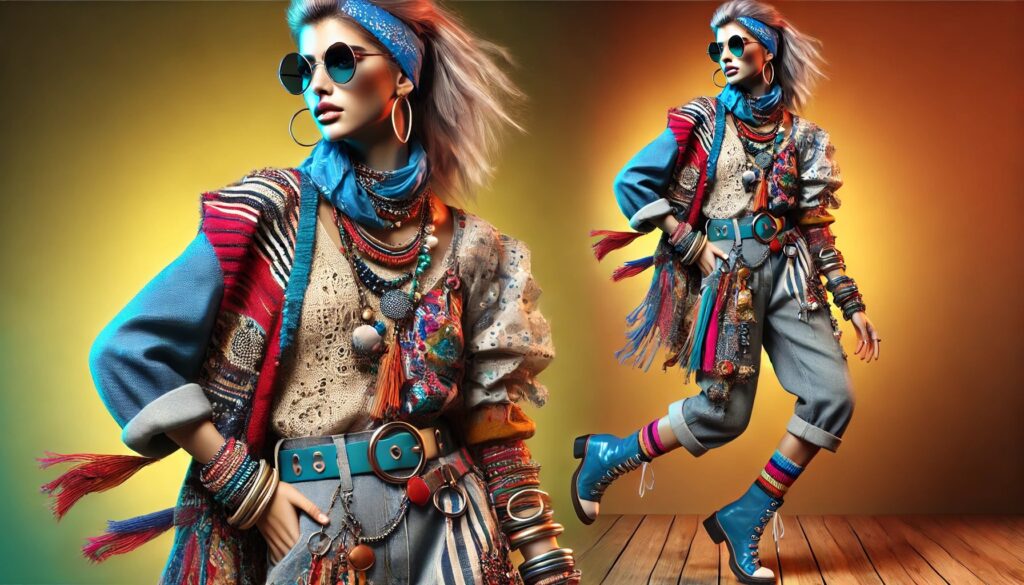
Choose Quality Over Quantity:
In a world dominated by fast fashion and constant trends, it’s easy to fall into the trap of purchasing cheap, trendy items that promise to give you the latest look for a fraction of the cost. However, when it comes to building a wardrobe that lasts, choosing quality over quantity is one of the best strategies you can adopt.
This mindset is about investing in fewer, but better-made pieces rather than filling your closet with inexpensive, lower-quality items that may quickly fall out of style or degrade after a few wears. Let’s dive into why this philosophy is so important and how it can transform your wardrobe and overall style.
1. Longevity and Durability:

One of the main reasons to choose quality over quantity is longevity. High-quality clothing is designed to last longer, withstand wear and tear, and maintain its appearance even after multiple washes.
How Quality Affects Durability:
Better Fabrics: Quality fabrics, like wool, silk, high-quality cotton, and leather, are more durable and resistant to damage than cheap synthetics like polyester or acrylic. They retain their shape, color, and texture for longer periods.
Superior Craftsmanship: Well-made clothes often feature reinforced stitching, stronger buttons, and better finishing touches. These small details contribute to the overall durability of a garment. For example, a high-quality pair of jeans may have double-stitched seams and strong rivets, making them last for years.
Wear Resistance: Quality fabrics and construction can handle repeated washing and use without losing their integrity. A good-quality wool sweater, for instance, will not pill or stretch out after a few wears like a cheap one might.
When you choose quality, you’re investing in pieces that will remain in your wardrobe for many seasons, saving you money in the long run as you don’t need to replace them as often.
2. Sustainability and Environmental Impact:
Choosing quality over quantity is also a more sustainable choice. Fast fashion relies on mass production, low-cost materials, and poor labor conditions to churn out new collections quickly. The result is excessive waste, overconsumption, and environmental degradation.
Why Quality Equals Sustainability:
Less Waste: High-quality items are built to last, reducing the frequency with which you need to replace them. This means fewer clothes end up in landfills, where they contribute to environmental harm.
Eco-Friendly Materials: Many quality brands use sustainable fabrics like organic cotton, linen, hemp, or recycled fibers, which have a much lower environmental footprint compared to the synthetic materials used in fast fashion.
Slow Fashion: By choosing quality, you’re embracing the slow fashion movement, which prioritizes thoughtfully made garments over cheap, mass-produced ones. Slow fashion promotes the idea of buying fewer pieces but investing in high-quality, timeless designs.
Each time you opt for quality, you’re reducing your overall impact on the planet, helping to reduce waste, and supporting the shift towards a more eco-conscious fashion industry.
3. Timeless Appeal and Versatility:
Quality garments are often timeless, meaning they don’t rely on short-lived trends. Instead, they possess classic designs that remain stylish year after year, making them more versatile and easier to incorporate into different outfits and occasions.
Timeless Designs: Classic Styles: Items like a well-tailored blazer, a little black dress, or a pair of leather boots never go out of style. These versatile pieces can be dressed up or down and worn across multiple seasons, making them a staple in any wardrobe.
Neutral Colors: High-quality clothes are often available in neutral colors that pair easily with other items in your wardrobe. Neutral tones like black, white, navy, beige, and gray are easy to mix and match, creating multiple outfits with fewer pieces.
Adaptability: Timeless pieces don’t need to be constantly updated to stay fashionable. A quality sweater or pair of pants will always look appropriate, no matter the year or trend cycle.
Choosing quality means embracing a wardrobe built on versatile, adaptable pieces that won’t need constant replacing or updating as trends come and go.
Conclusion:
Choosing quality over quantity is more than just a fashion strategy, it’s a mindset that can positively impact your wardrobe, your budget, the environment, and your well-being. By prioritizing well-made, durable, and timeless pieces, you’ll build a wardrobe that lasts longer, reduces waste, and enhances your personal style. Additionally, making thoughtful and mindful purchases promotes sustainability and supports brands that value ethical production practices. Ultimately, quality is about longevity, versatility, and investment three qualities that help you create a wardrobe that not only looks good but also serves you well for years to come.
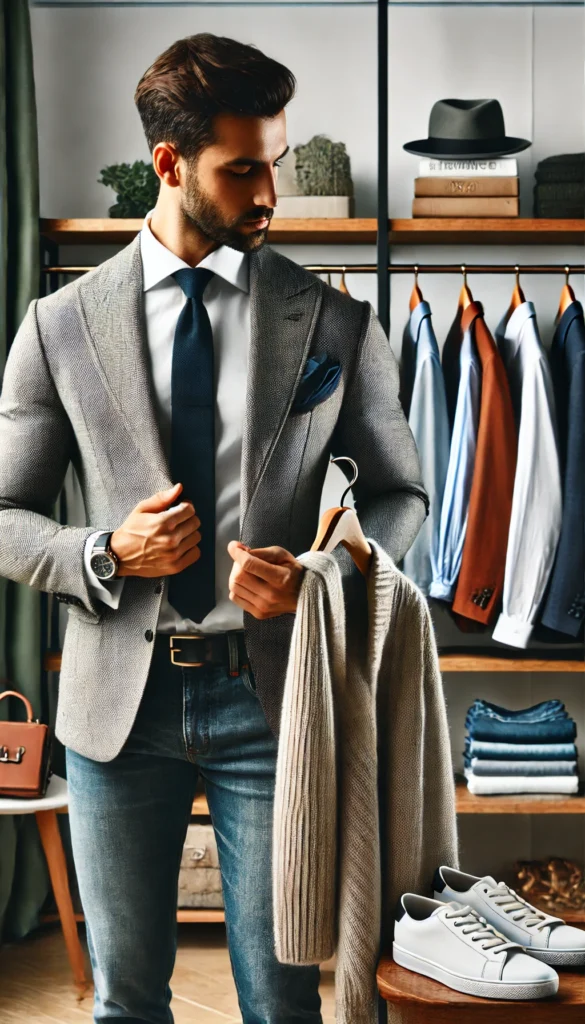

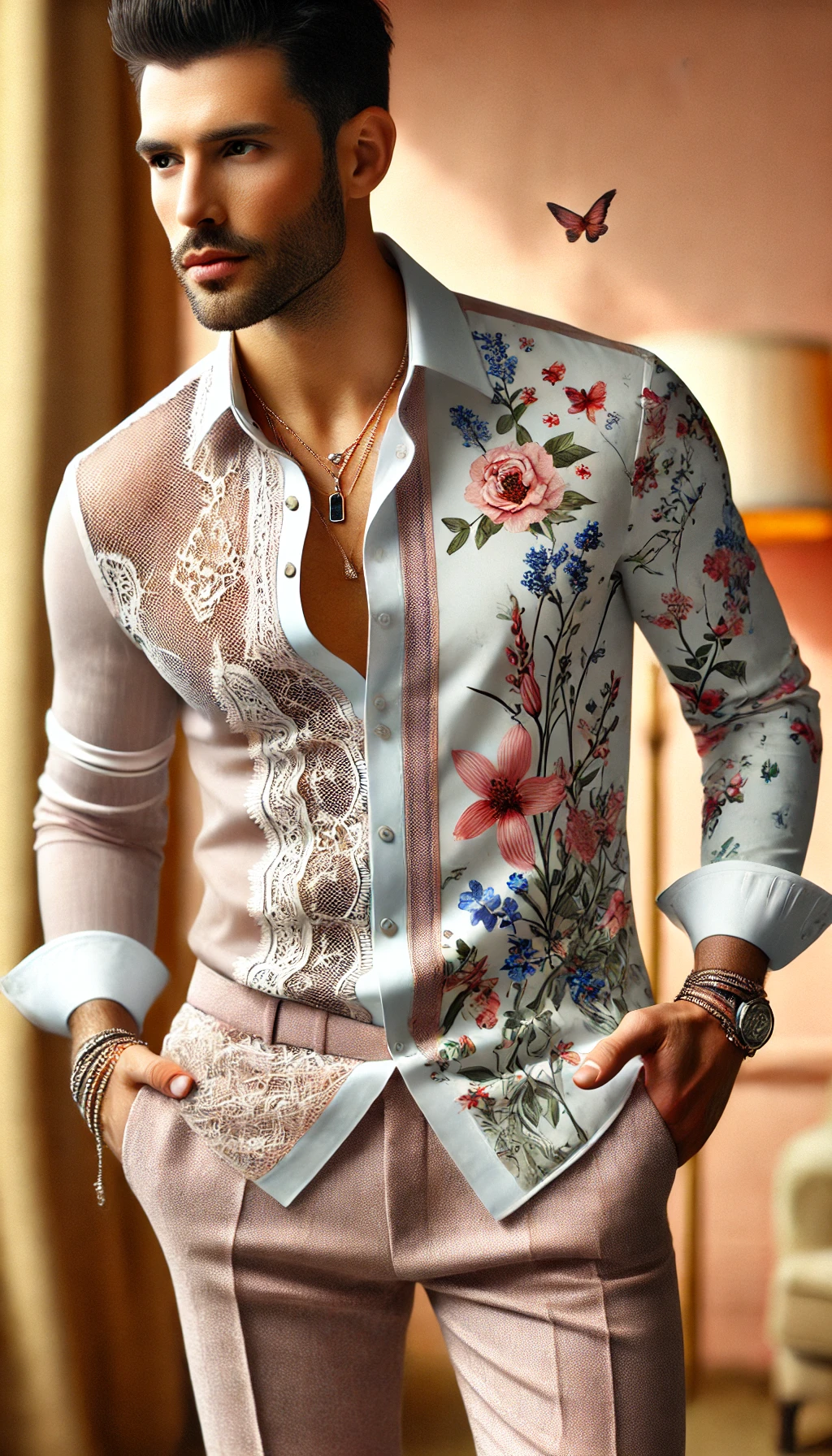
Choosing the right clothes is more than just a daily task; it’s a reflection of who we are and how we want to present ourselves. Comfort and confidence are key factors in making these decisions, as they directly impact our mental state and productivity. Curating a wardrobe that aligns with our personal style can simplify our lives and reduce stress. However, how do we balance practical comfort with the desire to express our individuality through fashion?
Choosing the right clothes is more than just a daily routine; it’s a reflection of who you are and how you feel. The clothes we wear can boost our confidence and comfort, making our day more enjoyable and productive. It’s important to have a curated wardrobe that aligns with your style and needs, reducing the stress of decision-making. Why do you think we often overlook the impact of our clothing choices on our mental and emotional well-being?